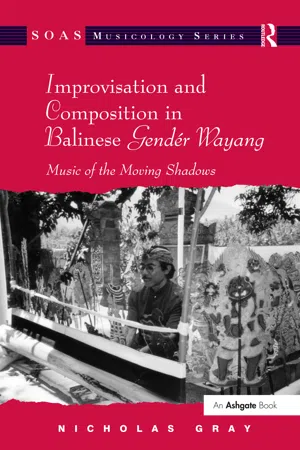Unlike the modern Balinese gong kebyar ensemble, complete new pieces are rarely composed for gendér wayang. However, there is an almost continuous process of reworking old pieces into new versions. Many of the pieces are, themselves, structured as variation forms: the concept of variation seems to be fundamental to the compositional technique. This study examines the scope and limits of such variation through discussions with player-composers, the musical analysis of old and new versions of pieces and of variation as a method of composition within the pieces themselves.
Compositional technique in gendér wayang is also of particular interest because of its remarkably varied principles of musical organization: it is not just built around the regular even note ‘nuclear’ melody of other gamelan types. It also has an unusually close relationship with vocal music as an accompaniment to the puppeteer’s songs.
This study concentrates, first and foremost, on processes of composition and musical change. However, it also necessarily addresses forces in modern Bali that affect these processes and give them shape and direction. Such forces include tourism, urbanization, political change, TV, radio, cassette culture and the local recording industry, government academies and religious reform. I can only, however, touch on these matters, which have been examined at length by Vickers (1989, 1996), Picard (1996), Bakker (1993) Heimarck (1999, 2002, 2003) and others.
It may seem paradoxical to examine composition in a genre in which there is supposed not to be any. I began to look at composition and variation-making in Balinese gendér wayang for three main reasons. Firstly, I became interested in the processes by which the same pieces seemed to change through time, but apparently new ones were rarely written, unlike the modern gamelan gong kebyar. Secondly, although there was supposed to be little or no improvisation in Balinese gamelan, I found that gendér players adopted a very flexible approach to their music and that this spontaneous variation-making seemed to be linked to players’ more ‘worked-out’ versions. Thirdly, there was the shock I experienced when, after several years’ learning, I was finally allowed to take part in a wayang performance and found that completely different versions seemed to come into play in performance. This prompted me to take on a study of the relationship between the conscious composition of pieces and parts of pieces with more spontaneous variation-making in this ensemble.
Though this study is limited to gendér wayang, it has repercussions for examining composition in other Balinese genres. The processes involved in creating new versions of gendér wayang pieces seem to feed into compositional methods for creating completely new pieces in other ensembles and may be reflected in other art forms.
These processes will be examined in two main geographical areas: Sukawati in South Bali, and secondly the contrasting area of East Bali, particularly the villages of Budakeling and Tenganan. Although Gold (1992 and 1998) and Heimarck (1999 and 2002) discuss Sukawati gendér style, my own familiarity with it provides a useful starting point from which to make comparisons with East Bali, an area more remote from current centres of power and modernization. Vonck (1995 and 1997) covers aspects of gendér in North Bali but, to date, nothing has appeared on East Balinese gendér traditions. None of these theses focus primarily on composition, variation and improvisation. I am aware that there are many other regional styles and many more player-composers who could have been consulted and hope that they and other readers will forgive this limitation. I hope, nevertheless, that the material I do present will give insight into the processes I discuss.
David Harnish states: ‘Composition in world musics is a subject sometimes overlooked by ethnomusicologists, who more usually explore musical tradition, performance practices and theories, issues of statehood and identity, or gender and cultural studies. However, a study of composition can unveil rich and profound values within a music culture’ (Harnish 2000:1). Sloboda, however, warns that ‘composition is the least studied and least well understood of all musical processes’ (Sloboda 1985:103).
To attempt a complete analysis of the ‘poetics’ of Balinese gendérwayang, following Nattiez (1990) would be an almost impossible task. However, Nattiez’s description of the scope of such a study depicts the potential conceptual space to be explored:
the link among the composer’s intentions, his creative procedures, his mental schemas, and the result of this collection of strategies; that is the components that go into the work’s material embodiment. (Nattiez 1990:92)
An analysis of this grouping should also include an awareness of the importance of Nattiez’s other element, the ‘esthesic process’ involving the listener or receiver (Nattiez 1990:17). This is the space that I hope to explore, in a limited way, in this study.
